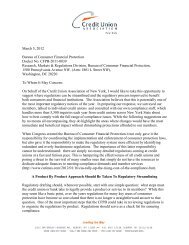Published by the Credit Union Association of New York
Published by the Credit Union Association of New York
Published by the Credit Union Association of New York
Create successful ePaper yourself
Turn your PDF publications into a flip-book with our unique Google optimized e-Paper software.
paymentsolutions<br />
Getting ready for EMV<br />
By Kimberly McCumber-Plo<strong>of</strong>, Chief Operating Officer, Covera<br />
EMV CARDS. CHIP TECHNOLOGY. IF YOU FOLLOW THE<br />
payments industry, you’re seeing <strong>the</strong>se terms more and more<br />
<strong>of</strong>ten. So what’s all <strong>the</strong> buzz about EMV card technology,<br />
and what should your credit union be doing to prepare for<br />
its move to <strong>the</strong> U.S.? Let’s take a closer look.<br />
How EMV works<br />
EMV cards (named for Europay MasterCard and Visa)<br />
store payment information in a secure chip instead <strong>of</strong> a<br />
magnetic stripe. They are not swiped like a magnetic stripe<br />
card; instead, <strong>the</strong>y’re inserted into a slot on <strong>the</strong> POS terminal.<br />
A metal contact on <strong>the</strong> face <strong>of</strong> <strong>the</strong> card <strong>the</strong>n connects <strong>the</strong> card<br />
to <strong>the</strong> terminal, and <strong>the</strong> two devices are able to communicate.<br />
Most EMV cards also have magnetic stripes for use at<br />
terminals that haven’t been upgraded to EMV.<br />
A dual interface EMV card, or a card capable <strong>of</strong> both<br />
contact and contactless transactions, can be ei<strong>the</strong>r tapped<br />
at <strong>the</strong> POS terminal for a contactless transaction or inserted<br />
into <strong>the</strong> EMV card reader for a contact based transaction.<br />
Enhanced security<br />
An EMV chip can store information, perform processing,<br />
store secret information securely and perform cryptographic<br />
processing. Unlike a magnetic stripe card, it is virtually<br />
impossible to create a counterfeit EMV card that can be used<br />
successfully. Smart Card Alliance describes <strong>the</strong> enhanced<br />
security <strong>of</strong> EMV technology in four layers:<br />
1. An EMV card’s security credentials are encoded <strong>by</strong><br />
<strong>the</strong> card issuer at personalization, stored securely in<br />
<strong>the</strong> EMV card’s chip, and cannot be accessed <strong>by</strong><br />
unauthorized parties. Criminals have yet to find a<br />
way to clone a chip! As a result, <strong>the</strong> cards help prevent<br />
card skimming and card cloning, one <strong>of</strong> <strong>the</strong> common<br />
ways magnetic stripe cards are compromised and<br />
used for fraudulent activity.<br />
2. An EMV transaction includes three components:<br />
The card is au<strong>the</strong>nticated; <strong>the</strong> cardholder is verified;<br />
and <strong>the</strong> transaction includes dynamic data and is<br />
authorized online or <strong>of</strong>fline, according to issuerdetermined<br />
risk parameters. As described above,<br />
Begin educating<br />
yourself and<br />
preparing your staff.<br />
each <strong>of</strong> <strong>the</strong>se transaction security features helps to<br />
prevent fraudulent transactions.<br />
3. Every EMV transaction carries dynamic data, so if<br />
a fraudster is able to steal account data from chip<br />
transactions, <strong>the</strong> data can’t be used to create a<br />
fraudulent transaction in an EMV or magnetic stripe<br />
environment.<br />
4. Because EMV cardholders use <strong>the</strong>ir cards and<br />
individual readers to au<strong>the</strong>nticate Internet transactions,<br />
<strong>the</strong> technology can also prevent card-not-present<br />
(CNP) fraud.<br />
Coming (slowly) to <strong>the</strong> U.S.<br />
Despite <strong>the</strong> security benefits, <strong>the</strong> United States chose not<br />
to implement EMV when Europe, Canada, Latin America<br />
and Asia initially began migrating toward <strong>the</strong> technology.<br />
There are several reasons for our slow adoption, including:<br />
• There are substantial costs associated with <strong>the</strong><br />
deployment <strong>of</strong> an EMV infrastructure.<br />
• Chip cards are more expensive than magnetic stripe<br />
cards.<br />
• POS terminals require additional features to read <strong>the</strong><br />
card.<br />
• Legacy back-<strong>of</strong>fice systems must be upgraded to<br />
accommodate <strong>the</strong> technology.<br />
But despite <strong>the</strong>se “cons,” U.S. migration to chip technology<br />
has become inevitable. As <strong>of</strong> Q3 2011, <strong>the</strong>re were more than<br />
1.34 billion EMV compliant chip-based payment cards in use<br />
worldwide (EMVCo). U.S. travelers have faced rejection <strong>of</strong><br />
8 SEPTEMBER 2012 Connection






